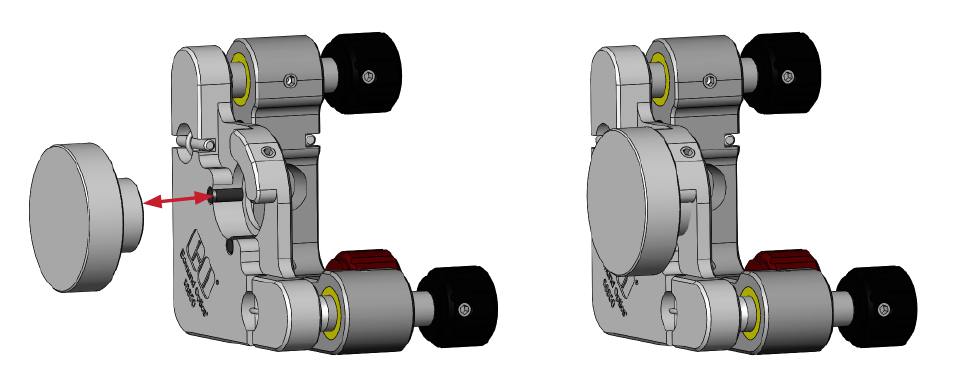
|
|
Patent pending geometry featuring a stem protruding from the back of the mirror |
|
|
Significantly reduces stress on the reflective surface, avoiding surface deformation |
|
|
Decouples surface stress and positional stability when mounted by stem |
|
|
Cost is less than that of existing solutions with similar performance |
Mounting flat mirrors by their edges in a kinematic mount imparts stress onto the mirror surface. This results in distortion and reduced quality of the reflected wavefront, which is especially noticeable when using high-quality mirrors. Stemmed mirrors, on the other hand, are mounted from a smaller diameter “stem” protruding from the back of the mirror, resulting in significantly reduced stress on the mirror surface, high stability, and cost reduction and can be used as a replacement for a more expensive and complex kinematic mount and a conventional mirror.
The flatness specified for a first surface mirror may not reflect the actual flatness of it in its end application. Positioning the mirror in a mount and applying pressure to secure it distorts the surface, degrading the quality of the reflected wavefront. Such was the case when engineers from Edmund Optics® mounted a conventional mirror with a flatness of λ/10 and secured it with up to 12 in-oz of torque (“hand-tight”). The flatness degraded to λ/5, changing the specification by a factor of 2.
Stemmed mirrors feature monolithic glass substrates shaped into their characteristic geometry. All contact between a stemmed mirror and its mechanical mount is through the mirror’s stem, significantly decreasing the stress imparted on the mirror surface (Figure 1). A simple kinematic mount can secure stemmed mirrors with a high degree of positional stability without noticeably impacting performance. In order to maintain a similar flatness, conventional mirrors would need to be secured using much more complex and expensive kinematic mounts. The total cost of a stemmed mirror and a simple mount is less than that of a conventional mirror and the complex mount that would be required to maintain a similar flatness.

To quantify the level of aberrations introduced to both a λ/10 stemmed mirror and a λ/10 conventional first surface mirror, both were placed in an identical kinematic mount while a controlled amount of torque was applied. As shown in Figure 2, the stemmed mirror maintained its λ/10 flatness specification through up to 12 in-oz of torque (which is considered “hand-tight”) while the conventional mirror went out of specification under the same torque with a final flatness of λ/5. Figure 2 also separates the contributions of different classifications of optical aberrations, revealing that the most detrimental aberration was astigmatism, followed by power error.







 What coatings are available on Edmund Optics’ Stemmed Mirrors?
What coatings are available on Edmund Optics’ Stemmed Mirrors?
 What exactly about Stemmed Mirrors is patent pending?
What exactly about Stemmed Mirrors is patent pending?
The unique geometry designed to minimize surface stress and deformation of Stemmed Mirrors is patent pending under U.S. Provisional Patent Application No.: 63/080,154.
 What kinematic mounts would you recommend for use with Stemmed Mirrors?
What kinematic mounts would you recommend for use with Stemmed Mirrors?
The TECHSPEC® E-Series Kinematic Mounts and TECHSPEC® Kinematic Circular Optical Mounts are ideal for use with Stemmed Mirrors.
 Can Edmund Optics make custom Stemmed Mirrors with different specifications than your standard options?
Can Edmund Optics make custom Stemmed Mirrors with different specifications than your standard options?
Yes, contact us to discuss your specific requirements.
or view regional numbers
QUOTE TOOL
enter stock numbers to begin
Copyright 2025 | Edmund Optics BV, De Maas 22B, 5684 PL Best, The Netherlands
California Consumer Privacy Acts (CCPA): Do Not Sell or Share My Personal Information
California Transparency in Supply Chains Act
The FUTURE Depends On Optics®